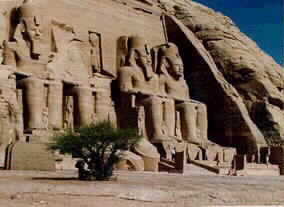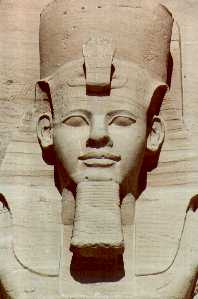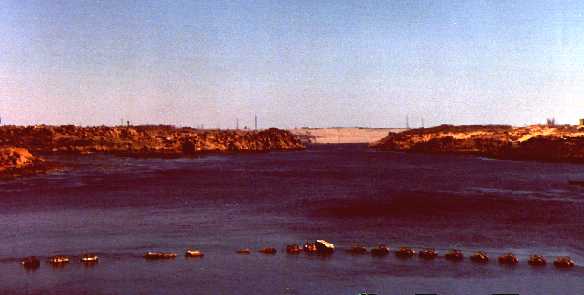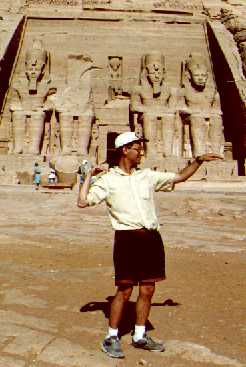
 |
Abu Simbel, Egypt |

The Great Temple of Abu Simbel
The Temples of Abu Simbel are the greatest surviving masterpiece of construction by the Pharaoh Ramses II. Ramses II ruled Egypt for 60+ years (1290-1224 BCE). During his long mostly peaceful reign he was able to dedicate his energies to constructing monuments throughout his realm. Hundreds of buildings throughout ancient Egypt can be attributed to Ramses II, including massive additions to the Temples of Luxor and Karnak in Luxor. Some of these were his doing, others were claimed by him, when in fact he only provided a statue or two - of himself.
The temples of Abu Simbel were constructed at the southern edge of Egyptian influence in the tributary country of Nubia. Today they stand at a similar frontier a few kilometers north of the Egyptian-Sudanese border.
 There
are two temples at Abu Simbel, called simply the Great and Small.
The Great Temple is truly astounding in size. It was carved 63m into
a stone cliff. It's front facade is 33m high and dominated by four
20m high statues of Ramses. Inside eight additional statutes 10m
tall line the main entry way. Inside its many rooms are hieroglyphic
(symbolic) writing describing Ramses many exploits in his first 30 years
as ruler of Egypt. The Great Temple was also carefully crafted so
that the light of the rising sun would penetrate to its holiest of holy
shrines on February 20th and October 20th each year (leading to speculation
that one of these dates was the anniversary of Ramses coronation).
There
are two temples at Abu Simbel, called simply the Great and Small.
The Great Temple is truly astounding in size. It was carved 63m into
a stone cliff. It's front facade is 33m high and dominated by four
20m high statues of Ramses. Inside eight additional statutes 10m
tall line the main entry way. Inside its many rooms are hieroglyphic
(symbolic) writing describing Ramses many exploits in his first 30 years
as ruler of Egypt. The Great Temple was also carefully crafted so
that the light of the rising sun would penetrate to its holiest of holy
shrines on February 20th and October 20th each year (leading to speculation
that one of these dates was the anniversary of Ramses coronation).
The Small Temple is dedicated to Ramses favorite wife Nefertari and shows her standing on a level equal to her husband. This is unusually high praise to an Egyptian woman. Typically in ancient Egyptian art women are carved as microscopic figures kissing the ankle of her gigantic husband.
 Travel
to Abu Simbel is done along a route which runs a few miles to the west
of the Nile. Any deviation from the Nile river and one is in unquestionably
inside the Sahara Desert. The Sahara is the world's largest at 9,065,000
sq. km (3,500,000 sq. mi) running some 4800 km east to west and 1900 km
north to south. Rainfall typically less than 13 cm per year if any.
Temperatures can drop below freezing or raise above 57°C (135°F).
The stretch near Abu Simbel is the most inhospitable place I've ever been.
Not one plant, not one rock offers the slightest hint of life. The
only hope for survival comes from the tcruel teasing of the mirages that
look so much lake large lakes, but are nothing but more hot air.
Travel
to Abu Simbel is done along a route which runs a few miles to the west
of the Nile. Any deviation from the Nile river and one is in unquestionably
inside the Sahara Desert. The Sahara is the world's largest at 9,065,000
sq. km (3,500,000 sq. mi) running some 4800 km east to west and 1900 km
north to south. Rainfall typically less than 13 cm per year if any.
Temperatures can drop below freezing or raise above 57°C (135°F).
The stretch near Abu Simbel is the most inhospitable place I've ever been.
Not one plant, not one rock offers the slightest hint of life. The
only hope for survival comes from the tcruel teasing of the mirages that
look so much lake large lakes, but are nothing but more hot air.
 Several
hours to the north of Abu Simbel is Aswan, the southernmost major city
in Egypt. For many thousands of years Aswan was a mining center where large
tons of granite were excavated and shipped south to all the major construction
projects in the north.
Several
hours to the north of Abu Simbel is Aswan, the southernmost major city
in Egypt. For many thousands of years Aswan was a mining center where large
tons of granite were excavated and shipped south to all the major construction
projects in the north.
Historically, Aswan is Egypt's traditional southern border. The reason for this is the presence of the first cataract of the Nile river. The large concentration of rocks and the high speed of water through this relatively narrow stretch of the river renders the Nile impassable by large boats. Thus Aswan is as far upstream a boat from the ocean can navigate without being dragged out of the water.
Aswan is consequently the first convenient point to construct a dam which can tap the tremendous potential energy of the Nile. The first such dam was constructed with help of Britain in the early 20th century, but it was a fairly small effort which failed to meet the demands of Egypt by the 1950's. When the founder of modern Egypt Gamel Abdul Nasser rose to power in 1956, constructing a dam became one of his top priorities. He essentially went to war with Britain, France and Israel to secure government control of the Suez Canal to help finance his dream and brought his country into alliance with Russia to obtain the necessary technical know-how.
 The
end result is an achievement as great as any of ancient Egypt. The
Sad El-Aali (Aswan High Dam), is one of the largest of its kind.
It is 3.6 km long, 980 thick at its base and 111m high, or in other words
its volume is 17 times larger than the largest pyramid.
The dam's 12 turbines now produce over 2 megawatts of power. Damming
the river has produced 30% more irrigable land to help feed Egypt's soaring
population, and also provides protection from the large floods that periodically
devastated Egypt from time to time.
The
end result is an achievement as great as any of ancient Egypt. The
Sad El-Aali (Aswan High Dam), is one of the largest of its kind.
It is 3.6 km long, 980 thick at its base and 111m high, or in other words
its volume is 17 times larger than the largest pyramid.
The dam's 12 turbines now produce over 2 megawatts of power. Damming
the river has produced 30% more irrigable land to help feed Egypt's soaring
population, and also provides protection from the large floods that periodically
devastated Egypt from time to time.
 The
construction of the dam also created Lake Nasser, one of the world's largest
artificial lakes in the world, with a volume of 135 billion cubic meters.
The creation of the reservoir caused several problems for Egypt, including
the seepage of water into the surrounding rocks, and blocking the flow
of the tremendously fertile soil that the Nile used to bring down from
Ethiopia and the Sudan. But the most dramatic consequence of the
creation of the reservoir was the flooding and destruction of the lands
of the Nubian people. The people were relocated, but most of the
ancient cultural treasures of these people were destroyed.
The
construction of the dam also created Lake Nasser, one of the world's largest
artificial lakes in the world, with a volume of 135 billion cubic meters.
The creation of the reservoir caused several problems for Egypt, including
the seepage of water into the surrounding rocks, and blocking the flow
of the tremendously fertile soil that the Nile used to bring down from
Ethiopia and the Sudan. But the most dramatic consequence of the
creation of the reservoir was the flooding and destruction of the lands
of the Nubian people. The people were relocated, but most of the
ancient cultural treasures of these people were destroyed.
As plans for the dam went forward the United Nations took it upon itself to save as many of these treasures as it could before completion of the dam. The two most notable successes in this area was the relocation of the Temple of Philae near Aswan and Abu Simbel. The Large Temple was carefully sliced into 807 blocks each weighing 20 tons while the smaller temple was cut into 235 such blocks. The two temples were 180m to the northwest to a position 65m higher. The reassembled temples were reinforced by a stronger cement structure and was covered by large cement dome. While the cliff face which surrounded the original temple could not be replaced, the temple was covered over by piles of local rocks.
 The
work, performed under extreme time pressure as the waters of Lake Nasser
rose up to the level of the temple, was well done, but not perfectly.
The reassembled Great Temple was slightly misaligned and the day the sunlight
penetrates to the holy of holies in the Great Temple is now one day off.
A few locations where pieces had been lost had to be replaced by bare cement.
Visitors find themselves as much looking at the quality of the relocation
work as well as the magnificence of the original creation. This is
much the same feeling I felt I had visiting recreations at Disneyland in Los Angeles.
The
work, performed under extreme time pressure as the waters of Lake Nasser
rose up to the level of the temple, was well done, but not perfectly.
The reassembled Great Temple was slightly misaligned and the day the sunlight
penetrates to the holy of holies in the Great Temple is now one day off.
A few locations where pieces had been lost had to be replaced by bare cement.
Visitors find themselves as much looking at the quality of the relocation
work as well as the magnificence of the original creation. This is
much the same feeling I felt I had visiting recreations at Disneyland in Los Angeles.
| Grand Central Station | |
|---|---|
|
|
|